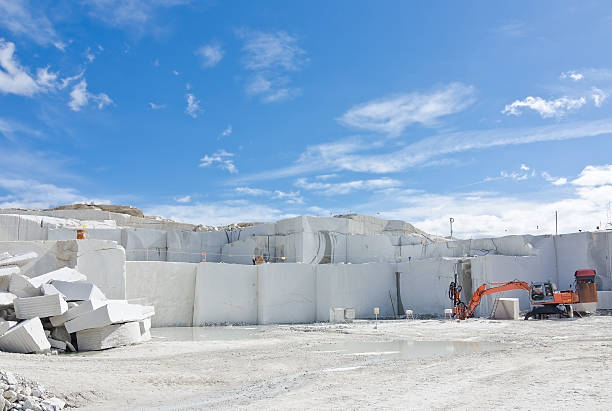Introducing Granite Quarries in South Africa Legacy: A Trip With Quarries
Introducing Granite Quarries in South Africa Legacy: A Trip With Quarries
Blog Article
Discovering the Rich Background and Sustainable Practices of Granite Quarrying
As we depend on the precipice of discovering the detailed tapestry of granite quarrying, a trip through time exposes not just the physical act of removing stone but likewise the cultural and historic value woven right into the extremely fabric of this practice. From the old beginnings that laid the foundation for modern quarrying techniques to the sustainable practices that are shaping the future of this market, each carve mark on granite surface areas narrates waiting to be discovered (granite quarries in south africa). The legacy of granite quarrying stretches far past simple extraction; it is a testimony to human ingenuity, resilience, and the enduring appeal of this impressive stone
Old Beginnings of Granite Quarrying
Dating back to ancient civilizations, the practice of quarrying granite has been an important part of human history and building improvement. The earliest proof of granite quarrying days back to old Egypt, where substantial pyramids and complex sculptures were crafted from this resilient stone. The Egyptians used primitive devices to draw out granite blocks from quarries, showcasing the relevance of this material in their monumental building and constructions.
Progressing in background, the Greeks also made significant contributions to the quarrying of granite. The Greeks utilized granite in numerous architectural wonders, such as temples and statues, showing their skill in shaping and sculpting this sturdy rock. The Romans further refined the strategies of quarrying granite, utilizing advanced devices like blades and hammers to remove and form granite for their legendary frameworks.
Through the centuries, the method of quarrying granite has actually developed, with modern technologies boosting effectiveness while maintaining the timeless appeal of this natural rock - granite quarries in south africa. From old human beings to contemporary building contractors, the legacy of granite quarrying proceeds to shape our world
Advancement of Quarrying Strategies
The evolution of quarrying strategies has been noted by a constant development in the direction of better performance and accuracy in extracting granite. From the primary methods utilized by our ancestors to the advanced technologies utilized in modern-day quarrying procedures, the sector has actually undergone considerable developments. Early quarrying techniques entailed hands-on labor with fundamental tools such as knives, hammers, and wedges to remove granite blocks from the earth. As civilizations advanced, strategies like fire-setting and primitive explosives were introduced to promote the extraction process.
In more recent times, the development of equipment transformed the quarrying industry, enabling much faster removal rates and enhanced performance. Technologies such as diamond cable saws, high-pressure water jets, and pneumatic drills have actually become conventional in modern quarries, permitting exact cutting and reduced waste. Developments in computer-controlled equipment and 3D modeling have actually maximized quarrying operations, my website leading to minimal ecological effect and enhanced sustainability techniques. As the need for granite continues to climb, the development of quarrying techniques remains important to meeting sector needs successfully and sustainably.
Social Significance of Granite
Granite holds a profound cultural significance across different people as a result of its long-lasting visibility in building masterpieces and revered monuments. From the magnificent pyramids of Egypt to the detailed makings of the Angkor Wat temple in Cambodia, granite has actually been a material of selection for expressing majesty and durability in social heritage. In ancient Rome, granite columns decorated holy places and public buildings, symbolizing toughness and permanence. The cultural importance of granite expands beyond its physical qualities; it personifies durability, security, and timelessness, making it a sign of enduring heritages and customs.

Lasting Practices in Quarrying
In the middle of the abundant history of granite quarrying and its social relevance lies a growing emphasis on sustainable methods within the market. As environmental recognition and problems concerning resource deficiency have heightened globally, the quarrying industry has actually increasingly welcomed lasting methods to reduce its impact on the environment and bordering neighborhoods.

Moreover, recovery and recovery of quarry sites post-extraction are indispensable to sustainable techniques. By bring back quarried locations to an all-natural or useful state, such as developing wild animals environments or leisure rooms, quarriers can offset the environmental impact of their operations and add positively to the local ecosystem.
Heritage of Granite Quarrying
With a historic backdrop steeped in workmanship and industrial development, what withstanding effect has granite quarrying left from this source on the landscape of modern-day culture? The heritage of granite quarrying transcends plain removal practices; it has actually formed building marvels, metropolitan landscapes, and cultural heritage worldwide. The long lasting nature of granite has actually made it a recommended option for monoliths, buildings, and infrastructure, standing as a testament to the skill and virtuosity of quarry workers across generations.
Additionally, the financial impact of granite quarrying can not be overlooked. The industry remains to offer job opportunity and drive neighborhood economic situations in areas where granite extraction is prevalent. It has actually likewise stimulated technological innovations in quarrying methods and tools, bring about a lot more efficient and lasting methods.
In terms of sustainability, the tradition of granite quarrying consists of efforts to alleviate ecological effects with reclamation projects and accountable source monitoring. By stabilizing financial passions with ecological stewardship, the market aims to guarantee that future generations can proceed to benefit from this enduring all-natural resource.
Verdict

Report this page